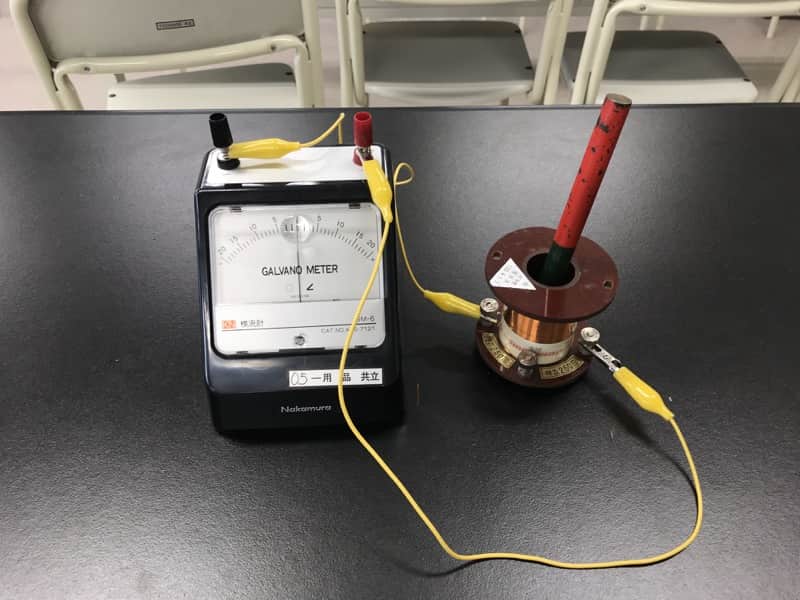The Law of Electromagnetic Induction: From “Power Plants” to “Hybrid Cars”! Unveiling the “Invisible Magic” That Powers Modern Society
The Voltage Generated by Electromagnetic Induction
Induced Electromotive Force [V] = Number of Turns [N] × Change in Magnetic Flux [ΔΦ/Δt]
First, let’s start with something familiar. When an electric current flows through a wire, a magnetic field (magnetic flux density) is created around it, right? And when you wrap the wire into a coil, a powerful magnetic field is generated at its center. In short, we can create a magnetic field by passing a current through something.
Current (movement of charge) → Creates a magnetic field!
This probably reminds you of the electromagnets you learned about in elementary school. But now, doesn’t a question pop into your mind? “Can’t we do the opposite and create a current from a magnetic field?”
Magnetic field → Creates a current?
If this were possible, we could generate electricity just by moving a magnet. This is exactly what “power generation” is. But can we really do that?
Let’s find out with an experiment. Take a wire and wrap it around a cylinder (about 3–5 cm in diameter) around 50 times to create a coil (a cardboard tube from a roll of plastic wrap works well). Then, connect the coil to a galvanometer (a device that measures the direction and magnitude of a current). The following diagram uses an experimental coil.

OK, let’s get ready! Now, gently place a bar magnet in front of this coil. Will a current flow?… Unfortunately, the needle of the galvanometer won’t move even a twitch. It seems that a stationary magnet doesn’t produce anything.
Now, let’s ask a slightly mischievous question. If you were the “God of Electricity,” what would you do to the magnet to make electricity flow through the coil? That’s right—you’d move the magnet!
Try quickly moving the magnet in and out of the coil’s cylinder. And what happens? The needle of the galvanometer swings widely to the left and right. This shows that a current is flowing. And when you stop moving the magnet, the current immediately stops as well.
Please also look at this image. When you turn the handle, the magnet rotates. And when the magnet passes near the coil, the light bulb glows for a moment. This was one of the exhibits at the Tsukuba Expo Center.
This remarkable phenomenon means that a current flows only when the magnetic field passing through the coil changes by moving the magnet. Just as a current creates a magnetic field, a change in a magnetic field can create a current.
This phenomenon, where a current is generated by a changing magnetic field, is called electromagnetic induction. The current that flows during this process is known as an induced current.
A Coil Hates Change—Is It Like a Spoiled Child?
The direction in which the induced current flows has an interesting pattern. For example, if you move the north pole of a magnet toward the coil, the current flows counter-clockwise. But if you move the north pole away from the coil, the current flows in the opposite, clockwise direction.
To understand this rule, let’s look at the magnetic field from a different perspective, using a physical quantity called magnetic flux. Magnetic flux is a way of bundling and counting magnetic field lines; the more magnetic field lines there are, the stronger the magnetic field (the higher the magnetic flux density) in that area.
A coil actually has a “stubborn” nature, much like a spoiled child: it tries to keep the magnetic flux passing through it constant. Let’s go back to our experiment. When you move the north pole of a magnet toward the coil, the downward magnetic flux passing through the coil increases. The coil then says, “I hate change!” and tries to create its own upward magnetic flux to cancel out the increase. According to the right-hand rule (where your thumb points in the direction of the magnetic field), the current flows counter-clockwise.
Conversely, what happens when you move the north pole away? The downward magnetic flux passing through the coil decreases. This time, the coil says, “I hate it decreasing, too!” and tries to create a downward magnetic flux to compensate for the decrease. As a result, the current flows clockwise.
In this way, the induced current is always generated in a direction that opposes the change in the external magnetic flux. This principle is known as Lenz’s Law. The voltage generated in the coil by electromagnetic induction is called the “induced electromotive force,” and its magnitude is expressed by the following formula.
Faraday’s Law of Electromagnetic Induction
V=−N×(ΔΦ/Δt)
Here, the minus sign (—) indicates Lenz’s Law (the opposing direction of the change). N is the number of turns in the coil, and is the rate of change of the magnetic flux over time. This shows that the faster you move the magnet (the larger becomes) and the more turns the coil has (the larger N is), the greater the voltage that is generated. This is known as Faraday’s Law of Electromagnetic Induction.
Electromagnetic Induction Powers Modern Society
The principle of electromagnetic induction is at work all around us, in countless applications that are vital to our daily lives.
AC Generators: The Heart of Power Generation
The law of electromagnetic induction is, quite literally, the principle behind the electrical generator. At power plants,regardless of the energy source—be it thermal, hydroelectric, or nuclear—the process ultimately involves rapidly spinning a massive coil within a magnetic field to generate electricity based on this very principle.
The electricity that reaches our homes is delivered as alternating current (AC),
Hybrid Cars and Regenerative Braking: Reusing Wasted Energy
Hybrid cars are equipped with an electric motor in addition to a gasoline engine. The amazing thing about this motor is that it doesn’t just power the car; it also acts as a generator when you decelerate. During braking, the car’s kinetic energy is converted into electrical energy using electromagnetic induction, which is then stored in the battery. This allows the car to reuse energy that would otherwise be wasted, leading to a significant improvement in fuel efficiency. This smart system is known as regenerative braking.
Eddy Current Brakes: The Contactless Stop of the Bullet Train
Try sliding a powerful magnet over an aluminum plate. It will suddenly stop as if an invisible brake has been applied. This is another application of electromagnetic induction.
When the magnet moves, an induced current called an eddy current is generated inside the metal plate. This eddy current creates a magnetic field that opposes the motion of the magnet, exerting a resistive force that brings it to a stop.
Utilizing this principle, eddy current brakes are used as auxiliary braking systems on high-speed trains like the Shinkansen and on large trucks. Since they don’t make direct contact with the wheels, there is no friction-induced wear, making them a highly valued, safe, and efficient braking system.
It’s amazing to think that the “stubborn” nature of a coil, which hates change, can generate the energy that powers our society and even ensure the safety of our vehicles. The principle of electromagnetic induction may seem complicated at first glance, but it’s really the power of “change” that’s at work all around us.


